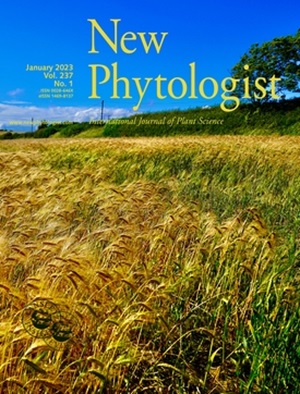OsSPL9促进高铁红壤水稻对铜的吸收和转运
IF 8.3
1区 生物学
Q1 PLANT SCIENCES
引用次数: 0
摘要
大多数水稻品种能够在红色高铁土壤中生长,但其潜在机制尚不清楚。通过正向遗传筛选,我们鉴定出一个红壤敏感1 (rss1)突变体,该突变体在红壤中生长时表现出严重的生长迟缓,但在肉桂土中没有明显的表型。在红壤/高铁条件下,rss1在根和芽中均表现出铁含量增加而铜(Cu)浓度降低的特征,并且rss1表型被Cu补充部分挽救。RSS1编码OsSPL9转录因子,在根木质部周围的中柱鞘细胞和薄壁细胞中表达。在高铁条件下,OsSPL9通过结合其启动子激活了包括OsYSL16、OsCOPT1和OsCOPT5在内的Cu转运体的表达,并且OsYSL16过表达部分挽救了rss1缺陷。因此,我们提出OsSPL9通过激活铜转运基因的表达来克服高铁造成的铜缺乏,使水稻能够适应红壤。本文章由计算机程序翻译,如有差异,请以英文原文为准。
OsSPL9 promotes Cu uptake and translocation in rice grown in high‐Fe red soil
Summary Most rice varieties are able to grow in red high‐Fe soil, but the underlying mechanism remains elusive. Through forward genetic screening, we identified a red soil‐sensitive ‐1 (rss1 ) mutant that exhibited severely retarded growth when grown in red soil but showed no evident phenotype in cinnamon soil. Under the red soil/high‐Fe conditions, rss1 exhibited increased Fe but decreased copper (Cu) concentrations in both roots and shoots, and the rss1 phenotype was partially rescued by Cu supplement. RSS1 encodes an OsSPL9 transcription factor that is expressed in pericycle cells and parenchyma cells surrounding xylem in roots. Under high‐Fe conditions, OsSPL9 activated expression of Cu transporters, including OsYSL16 , OsCOPT1 , and OsCOPT5 by binding to their promoters, and OsYSL16 overexpression partially rescued rss1 defects. We thus propose that OsSPL9 overcomes high‐Fe imposed Cu deficiency by activating the expressions of Cu transporter genes, allowing rice to adapt to red soil.
求助全文
通过发布文献求助,成功后即可免费获取论文全文。
去求助
来源期刊

New Phytologist
生物-植物科学
自引率
5.30%
发文量
728
期刊介绍:
New Phytologist is an international electronic journal published 24 times a year. It is owned by the New Phytologist Foundation, a non-profit-making charitable organization dedicated to promoting plant science. The journal publishes excellent, novel, rigorous, and timely research and scholarship in plant science and its applications. The articles cover topics in five sections: Physiology & Development, Environment, Interaction, Evolution, and Transformative Plant Biotechnology. These sections encompass intracellular processes, global environmental change, and encourage cross-disciplinary approaches. The journal recognizes the use of techniques from molecular and cell biology, functional genomics, modeling, and system-based approaches in plant science. Abstracting and Indexing Information for New Phytologist includes Academic Search, AgBiotech News & Information, Agroforestry Abstracts, Biochemistry & Biophysics Citation Index, Botanical Pesticides, CAB Abstracts®, Environment Index, Global Health, and Plant Breeding Abstracts, and others.
 求助内容:
求助内容: 应助结果提醒方式:
应助结果提醒方式:


